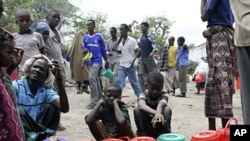The United Nations is planning to announce Monday that the famine in Somalia has now spread to the Bay region of the south-central area of the country.
A U.N. official told VOA the Office for the Coordination of Humanitarian Affairs in Somalia will announce that 4 million people - more than 50 percent of the population - are now in crisis. The famine is expected to spread further in coming months.
As one of the major food-producing areas of Somalia, the drought in Bay has had far-reaching implications.
|
Definition of Famine: The word famine is a term that is not used lightly by humanitarian organizations. The United Nations describes a crisis as a famine only when the following conditions are met:
Current Famine:
|
The U.N. official says food production in the region has fallen by 82 percent.
Many of the refugees who arrive at the camps in Kenya and Ethiopia, or those who seek help in Mogadishu, come from the Bay region. And aid agencies have had immense difficulty reaching the communities who are still there.
In a release this week, the U.N. noted reports that the al-Qaida-linked militant group al-Shabab has restricted movement in the area.
Bashir Mohammed is the Program Director for South Somalia with the Waabi Shebelle Development Association. His group is a partner to Oxfam and works in drought-stricken areas of Somalia, but not in Bay.
He says logistically, it is a very difficult place to work.
“Because of the access issues and, I think, you know, different factions control different areas, it's a challenge to reach, I think, those areas whereby most of the international staff cannot go and maybe agencies, like the local national agencies also don't have the capacity to respond to those regions in terms of responding to the emergency,” said Mohammed.
The United Nations first declared famine in Bakool and parts of the Shabelle regions July 20.
Since then, famine has also been identified in and among the displaced-people's communities of Mogadishu and the Afgoye corridor west of the capital.
Famine is a technical term indicating that malnutrition rates have exceeded 30 percent, that more than two people per 10,000 are dying each day, and that many cannot get access to food and other essentials.
U.N. officials stress that the situation in Somalia is dire and will continue to get worse before it gets better.












